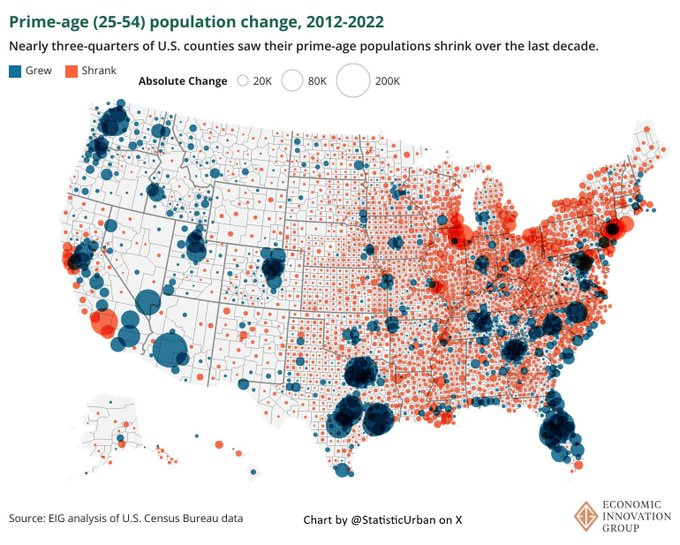Lessons from China's continuing population collapse
As China's fertility plunges toward South Korean levels, can we learn from their mistakes?
The year 2024 is a Dragon Year, according to the Chinese zodiac, the luckiest zodiac sign of all. In the past, couples sought to have a baby during such years, and the last dragon year, 2012, had a big baby boom with almost one million more babies born than the previous year.
While we don't know yet what the official numbers in China will be, signs from Taiwan are ominous. For the first half of 2024, Taiwanese births were down 3% compared to 2023. In the last dragon year of 2012, when there was a 17% increase. The Chinese dragon year baby boom may be a bust.
Meanwhile, marriages in China keep falling. Chinese demography expert @fuxianyi shared with me this chart on marriages in China. Births track marriages closely in China, and marriages have declined 13% so far in 2024, to the lowest levels ever.
In other words, it looks like China's fertility will keep falling in the years to come. In 2023, China's official fertility rate was just 1.02 births/woman, and China may now approach Korean levels.
The last time Chinese births were this low was before the founding of America!
The 9 million births recorded in China in 2023 is a fall of 70% from the 30 million births per year China was seeing 60 years ago, when the population was only half of what it is today. How small is this number of births for China? As Yi has written, the last time the number of Chinese births was this low was in the mid 1700s, when the Chinese population was just 180 million!
Instead of fearing that China will take over the world, we should probably worry about the global ramifications of a Chinese collapse. China has after all the world's first or second largest economy, depending on how you measure it.
What is causing this demographic collapse?
Low fertility in China has a range of causes. China's now-ended one-child policy casts a long shadow, as I wrote about recently. The loss of China's millennia-old tradition of arranged marriage is surely a factor.
But if you look at fertility data across China you find something remarkable. Cities like Shanghai and Beijing are leading the charge downward, with fertility rates below 0.6 births per woman. These are the lowest numbers anywhere on Earth, alongside similarly dense cities like Seoul and Macau.
And what is it about such cities that makes them so family unfriendly? They are extraordinarily crowded, denser than the densest western cities. (Chart by Yi).
That lower fertility follows urbanization is axiomatic in demography. We don't know all the reasons why, but this has been true throughout the world and has been true long before modern times. As Seoul and Shanghai show, there appears to be no limit to that effect: as cities keep getting denser, fertility keeps dropping, without any apparent floor.
China has embraced urbanization and density to an extraordinary degree and now is paying the price. Such density is totally unnecessary because cities are only 0.8% of Chinese land area.
But China continues to add to its huge stock of high-rise apartment towers in cities. These hold great appeal for young people, and so China continues to densify. For the foreseeable future, China may be stuck in a low birthrate regime. Below, the lights of Beijing.
Lessons for the world on housing
To the libertarian, the freedom to build anything anywhere feels like it should be absolute, and many libertarians now make this argument with a sense of moral certainty.
They see rules zoning rules favoring single family homes as an injustice to be righted, instead of sensible policy leaning into housing that is good for families. They close their eyes to the catastrophically low fertility of urban centers.
Meanwhile, builders are happy to erect as many apartments in towers as they have permission for. Young people flock into such apartments, which are great as long as you don't have kids. Build Baby Build, in the words of economist Bryan Caplan!
Will we ignore what is happening in Korea and China? They face fertility levels that are civilization-ending, and urban density is a big part of why.
China and Korea may be stuck with the density they have created, and the low fertility that results, for the foreseeable future. The urge to build and densify without limit is helping to bring down those beautiful cultures and may cripple the global economy.
Thinking about America's housing situation and growth
We hear daily of a housing crisis. Prices are high in a lot of areas and young people are having a hard time affording homes. This is surely hitting family formation negatively.
What is almost never discussed is that large areas of the country are depopulating (red in the map below). Houses are affordable across vast sections of the country, especially in the Midwest, but in almost every place on this map that appears in red.
There is a kind of social urge to want to be around other people, to seek out cities, and then bigger cities. Are we obligated to always follow that urge, as if everyone has a right to the same few urban areas even while much of the country empties out?
In the limit, that leads to a situation like in East Asia, with most people crowded into the same 1-3% percent of the land area and birthrates far too low to even sustain civilization.
In spreading out across the land, America was able to grow at an incredible pace in the past. Now following an opposite impulse toward densification, America and many other countries are on a path of decline. Yet with high-speed Internet and services such as Starlink, it is possible to be connected from anywhere.
Is there a way to grow economically without densifying so much? Given the fertility collapse unfolding in China and across Asia, it seems like we have to find a way.




